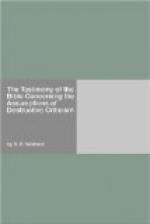Recurring to the passage in Numbers, we learn that, in the dire distress of the people for their sins, God commanded Moses to make a brazen serpent, and lift it up before the people, that they might look and live.
Certain of the critical school consent that Moses, was connected with the event, but did not record it. Indeed! And what proof that he failed to make the record? It was personal to himself. It was symbolically prophetic of the crucifixion of Christ, as our Savior used it, an event toward which all prophecy moved. And we have already learned that nine times it has been stated in the book of Numbers that the acts, precepts, and statutes of this book were done and given by “the hand of Moses.”
8. To the Jews, seeking to murder their Messiah, he said; “Do not think that I will accuse you to the Father; there is one that accuseth you, even Moses, in whom ye trust. For had ye believed Moses ye would have believed me, for he wrote of me.” (See John v. 45, 46.)
When and where did he write of Christ? He wrote of him in the five books which are ascribed to Moses by all the Old Testament Scriptures, and by Christ and his apostles. He wrote of him in Gen. iii. 15, when God promised that “the seed of the woman shall bruise the serpent’s head.” He wrote of Christ in Gen. xii. 3, when God promised Abraham: “In thee shall all families of the earth be blessed.” He wrote of the Messiah when he recorded Jacob’s prophecy in Gen. xlix. 10: “The scepter shall not depart from Judah, nor a lawgiver from between his feet until Shiloh come.” Moses wrote of Christ, when under divine direction he instituted the passover, as recorded in the twelfth chapter of Exodus.
He wrote of Christ in the Levitical ritual, when under God’s instruction he set up the system of types, for the tabernacle and the temple service, which taught the fundamentals of the New Testament gospel—redemption by the blood.
The whole tabernacle and its furniture was necessary to complete the symbolism that should represent the Messiah. The altar, the laver, the shew bread, the golden candlestick, the mercy seat, and the officiating high priest. For “Moses was admonished of God when he was about to make the tabernacle,” and received positive direction as to how he should construct it, that redemption should echo from every part of the service. Beautiful and glorious was the service that proclaimed “Christ and him crucified.” Christ’s testimony here is twofold: That “Moses wrote,” and that he “wrote of me,” of Christ, the witness of these things.
9. It was at the feast of tabernacles, in the year 29 A.D., that the Jews attacked the Savior in a fierce controversy, because he healed on the Sabbath day. He was teaching in the temple when they charged him with violating the Sabbath.
To that charge he replied: “Did not Moses give you the law? Yet none of you keepeth the law.” (See John vii. 19.) He affirms in most positive terms, that can not be twisted into the shadow of a negation, that Moses gave them the law. The interrogative form of his statement is rhetorically the strongest possible affirmation.




